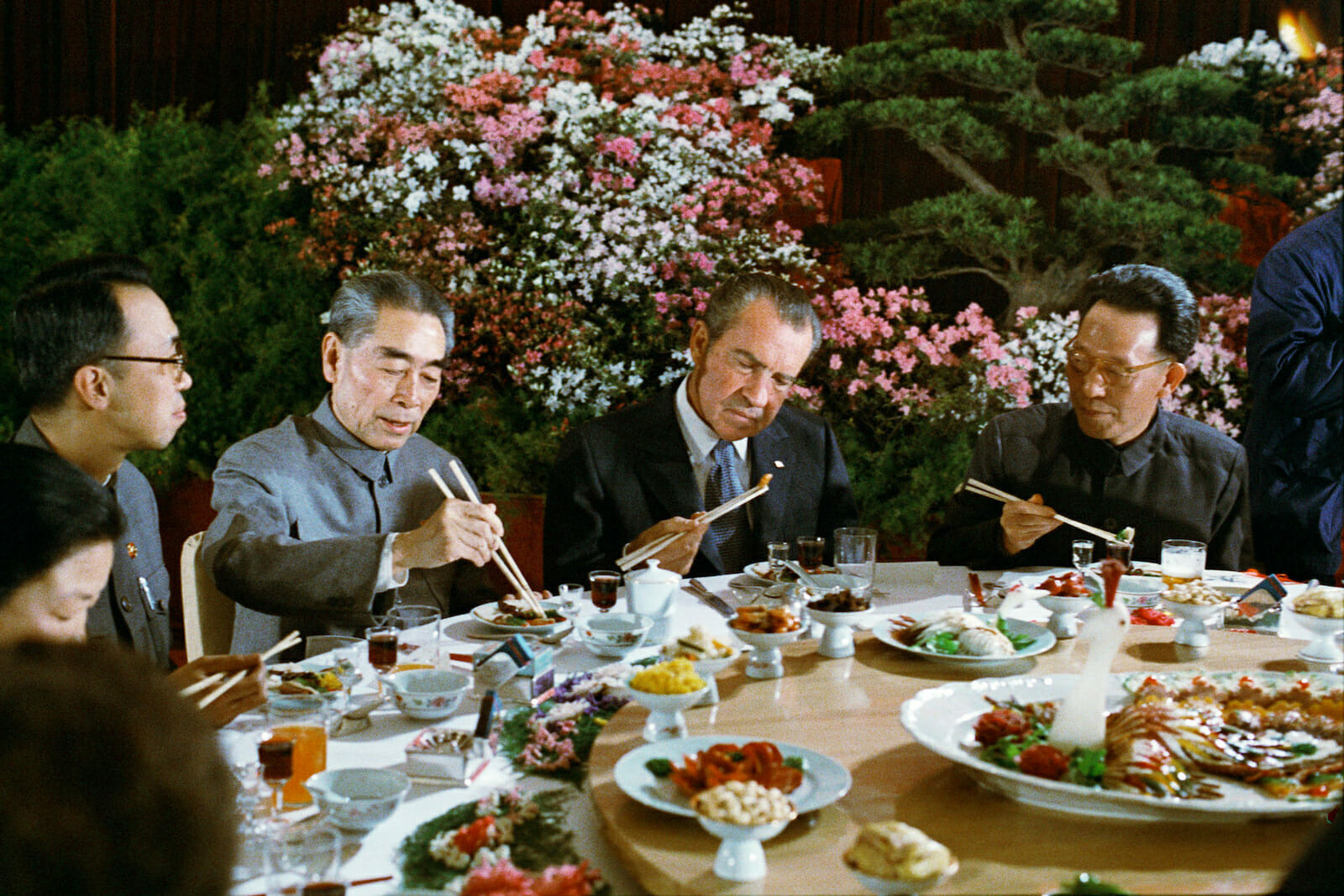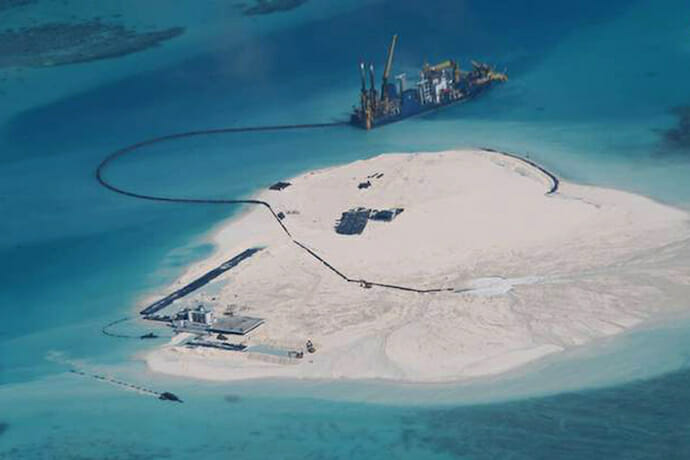
The Chinese Militarization of the South China Sea and the Shanghai Communique of 1972
When President Nixon sent Henry Kissinger to China in 1971, Nixon realized that the only practical way for the U.S. to disengage from Vietnam was with the aid of China. Without the logistical support from China, North Vietnam’s ability to conduct its war of liberation would be severely hampered and would help force North Vietnam to be more flexible in the Paris peace talks, which would allow the United States to withdraw from Vietnam with some semblance of honor.
Nixon also wished to blunt Russia’s ability to invade Western Europe, by creating an implicit tactical alliance with China. The rationale for China to turn to the West was its fear of Russia. The Sino-Soviet border conflict, which lasted for several months was the impetus for Mao to re-evaluate his foreign policy towards the U.S. and to also to form an implicit tactical alliance with the United States.
At times, the tensions between China and Russia flared into organized violence, with the clash of military forces in what Chinese historians have labeled the “Zhenbao Island” incident.
With the collapse of the Soviet Union in 1991, a major strategic opportunity opened for China. With Russia no longer a threat, and the economic reforms of 1978 already showing remarkable dividends for the Chinese economy, China only need wait until another opportunity presented itself, which occurred with the invasion of Iraq by the U.S. in March of 2003.
The end of the U.S. as a unipolar power and the rise of China and Russia.
After the fall of the Soviet Union in December of 1991, and before the invasion of Iraq by the United States in March of 2003, the United States was a unipolar power, in that no one nation could openly challenge the U.S. militarily. After the U.S. debacle in Iraq, and the total exhaustion of the military forces of the U.S., the world no longer viewed the U.S. as a unipolar power, especially China and Russia.
While the focus of U.S. foreign policy was on Iraq, China and Russia began to exert themselves more forcefully on the world scene.
China began its construction of artificial islands, Russia became more militant, and with the proper excuse, Russia appropriated part of Georgia during the Bush administration. Then during the Obama administration, Russia was able to seize the Crimea, and clandestinely set up political control of the eastern part of Ukraine.

The underlying cause of why China is expanding into the South China Sea.
The most critical issue that China faces today is its need to feed its people. The historical record of Chinese culture shows us that China’s population expands until it reaches a point where there is famine, whereupon it becomes aggressive militarily to obtain more food sources, or its population recedes.
The Food and Agriculture Organization of the United Nations has estimated that China’s per capita consumption of fish is 39.60 kilograms. While this estimate is much higher than the 9.66 kilograms released by the Chinese State Statistical Bureau Survey (SSB), this is due to the general unreliability of statistical information released by China.
China today consumes more fish than it produces. This shortage is aggravated by severe pollution of the Yangtze River, and the pollution of its saltwater fisheries. The pollution is caused by lax environmental protections that allows a massive number of factories in China to dump waste into China’s rivers. This waste is then flushed into the traditional Chinese saltwater fisheries, killing its fishing grounds, and forcing the Chinese to look farther out to sea to find food for its people. If China’s government fails in feeding its people, then the current government will lose its “Mandate of Heaven” and subsequently lose power. China’s inherent fear is another Tiananmen Square.
With China’s need to feed herself, she has expanded her deep-sea fishing fleets farther and farther away from her traditional fishing grounds.
China has had several incidents with its neighbors regarding the Chinese intrusion of deep-sea fishing into their exclusive economic zones (EEZ). From the coast of Chile to the fishing grounds of Indonesia, deep-sea fishing vessels, financed by Chinese government subsidies, have aggressively pushed its search for food into the EEZs of other countries.
Indonesia has had several incidents with Chinese fishing fleets intruding into their EEZ and has gone so far to rename its fisheries “The North Natuna Sea” rather than the South China Sea.
This is one of the major factors of China’s push into the South China Sea (SCS).
The strategic economic concerns of the United States in the Chinese militarization of the South China Sea.
When the United States invaded Iraq in March of 2003, it quickly became entangled in an aggressive guerrilla resistance, and thousands of jihadists flocked to Iraq to kill Americans.
While the U.S. was bogged down in Iraq, and its attention focused on the Iraqi war, China began constructing the artificial islands and began to force Filipino fishermen off their traditional fishing grounds.
While the Philippines won a judgment against China at the World Court, China has refused to abide by the decision of the World Court, even though China is a signatory to the treaty that was used against China at The Hague.

Under President Rodrigo Duterte, the Philippines has begun a slow drift into the Chinese economic, political, and military orbit. Yet, President Duterte is somewhat constrained as the U.S. has the broad support of the Filipino people. Whichever country the Philippines eventually allies itself with, the major concern of the U.S. is the free navigation of the South China Sea.
The primary concern that the U.S. has with the construction of artificial islands in the South China Sea, primarily in the Spratly Island group, is that China will try through military force to impose its sovereignty in an area that the UN has declared to be in the EEZ of the Philippines and has denied China’s claim of sovereignty over the South China Sea.
Over $3.6 trillion passes through the sea lanes of the South China Sea, and by constructing these artificial islands, and then militarizing them with radar, and airstrips, China is able to deny these sea lanes to the countries that depend upon them to sustain their economies. As a result of this threat China has prompted the United States, and other countries, to begin “Freedom of Navigation” patrols.
France has already conducted this type of patrols, with logistical support from the United States, and the United Kingdom will send one of its two new carrier task forces on a patrol as soon as the first task force is ready.
It is in the national security interests of the United States that there is no impediment to the free flow of trade in this area. The U.S. has publicly warned China not to declare an Air Defense Identification Zone (ADIZ) in the South China Sea.
The vulnerability of China’s artificial islands.
While the construction of these islands is impressive, it has been costly, and in the end for naught as these artificial islands are remarkably fragile.
The Chinese first built a double retaining wall, then drained whatever water was left inside the retaining walls. Trawlers then dredge up sand, and the sand is poured on top of coral, or reefs. The sand is then packed down, and then concrete is poured over the impacted sand.
While formidable, the artificial islands in the South China Sea are islands and not mobile airfields. With the islands themselves being as fragile as they are, and depending on a double sea wall to keep out the sea, any concerted effort by the U.S. Navy and allied forces would soon reduce these islands into useless slag and rubble if not causing enough destruction to allow the sea to reclaim what is rightfully the sea’s.
The U.S. under the Trump administration has warned the Chinese on its militarization of the SCS and is reinforcing U.S. naval forces in this area of the world.
The Shanghai Communique is no longer relevant to the national security interests of the United States with the Chinese militarization of the South China Sea.
At the beginning of this article, it was noted that the reason for the Shanghai Communique of 1972 in itself, was the belief of the U.S., and of China, that the biggest threat to the political stability of the region was the attempt by the then-Soviet Union to achieve Hegemon status.
The underlying reason for the temporary “tactical” alliance between the U.S. and China has long since disappeared. With the Soviet Union a thing of the past, and with the current weakness in the Russian economy, China no longer feels threatened by her northern neighbor, and so feels free to exert herself in the South China Sea and is behaving as a power attempting Hegemon status.
Because the economic future of the United States continues to lie in the Indo-Pacific region, and the internal political forces in the U.S. will force the current president, or the next president after 2021, to re-engage in Asian trade and re-enter the Trans-Pacific Partnership (TPP). Out of economic necessity, the U.S. will eventually be forced to decide whether the Chinese militarization of the South China Sea violates the Shanghai Communique of 1972 and if adhering to the Communique is in the national security interests of the U.S. and its friends and allies in the region.
This would not be in the interests of China as the Shanghai Communique commits the U.S. to a One China policy, with Taiwan being a part of China.
If China continues its militarization, China will force the U.S. to renounce the Shanghai Communique and to prevent China from using military force to physically occupy Taiwan, it would be necessary for the U.S. to recognize Taiwan as an independent nation.
Since China has already threatened military force should Taiwan declare its independence, the U.S. would be forced, along with Japan, to simultaneously sign a defense treaty with Taiwan and to have a robust military force to deter China from attacking Taiwan in place at the time of the declaration of independence by Taiwan.
If China continues with her militaristic expansion, then eventually China will have to fight, and in the end, she will have to fight alone.

